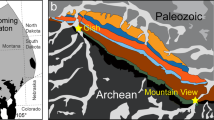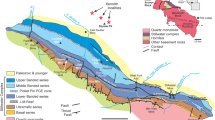Abstract
THE precise composition of the solid solutions that develop between diopside and enstatite has provided a basis for estimates of the temperature of equilibration of mineral assemblages from peridotites. We report here results of a reinvestigation of these relationships, which demonstrate that the range of solid solutions formed at high temperatures is less than previously believed, and that it is dependent on both pressure and silica activity. The stable existence of an iron-free pigeonite has not been confirmed.
Similar content being viewed by others
References
Nixon, P. H., and Boyd, F. R., in Lesotho Kimberlites (edit. by Nixon, P. H.), 48–56 (Lesotho National Development Corporation, Maseru, 1973).
Boyd, F. R., Geochim. cosmochim. Acta, 37, 2533–2546 (1973).
Davis, B. T. C., and Boyd, F. R., J. geophys. Res., 71, 3567–3576 (1966).
Kushiro, I., Yb. Carnegie Instn Wash., 67, 80–83 (1968).
O'Hara, M. J., Richardson, S. W., and Wilson, G., Contr. Miner. Petrol., 32, 48–68 (1971).
Davis, B. T. C., Yb. Carnegie Instn Wash., 63, 165–171 (1964).
Kushiro, I., ibid, 63, 101–108 (1964).
Author information
Authors and Affiliations
Rights and permissions
About this article
Cite this article
HOWELLS, S., O'HARA, M. Palaeogeotherms and the diopside–enstatite solvus. Nature 254, 406–408 (1975). https://doi.org/10.1038/254406a0
Received:
Revised:
Issue Date:
DOI: https://doi.org/10.1038/254406a0
- Springer Nature Limited
This article is cited by
-
Thermodynamics of multicomponent pyroxenes: II. Phase relations in the quadrilateral
Contributions to Mineralogy and Petrology (1994)
-
Subsolidus orthopyroxene-clinopyroxene systematics in the system CaO-MgO-SiO2 to 60 kb: a re-evaluation of the regular solution model
Contributions to Mineralogy and Petrology (1984)
-
An experimental study of Fe-Mg partitioning between garnet and olivine and its calibration as a geothermometer
Contributions to Mineralogy and Petrology (1979)
-
Palaeogeotherms: implications of disequilibrium in garnet lherzolite xenoliths
Nature (1978)
-
The bearing of phase equilibria in simple and complex systems on the origin and evolution of some well-documented garnet-websterites
Contributions to Mineralogy and Petrology (1978)





